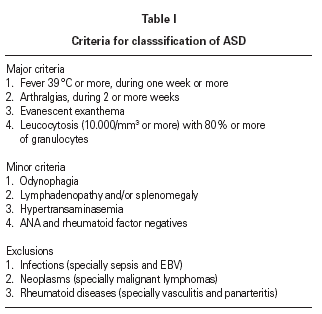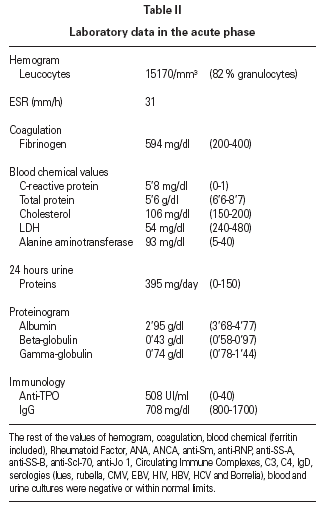INTRODUCTION
Adult Still Disease (ASD) is a rare (incidence 1-1,6/1.000.000 in Europe) seronegative polyarthropathy associated with sudden onset high fever and chills, with evanescent rash on the trunk and extremities. Bony erosions are uncommon, although fusion of the carpal bones may occur.
ASD is diagnosed with clinical criteria, excluding other etiologies.
Minocycline, a semisynthetic derivative of tetracycline, has been associated with serum sickness 2, hypersensitivity pneumonitis 3, Sweet's syndrome 4, poliarteritis nodosa 5, drug induced lupus 6 and hypersensitivity syndrome 7.
CASE REPORT
A 18 years-old man complained of maculopapular exanthema during the last 24 hours, was admitted to the emergency room (ER). He was taking oral minocycline (100 mg/12 h) the last 12 days because of an infected fat cyst in the left ear.
Suspecting an adverse drug reaction (ADR), minocycline was withdrawn and treatment with oral prednisone (30 mg/d) and dexclorpheniramine (6 mg/d) was started.
48 hours later he returned to ER presenting urticaria and symmetrical arthralgias (knees, elbows, wrists, metacarpophalangeal 2.º-3.º), fever 38 °C and odynophagia.
Physical examination showed maculopapular exanthema without signs of vasculitis, articular pain with active and passive movements without signs of arthritis and 2 posterocervical lymphadenopathies of inflammatory type. Cardiac and pulmonary auscultation and abdominal palpation showed no abnormalities.
Patient was admitted to the hospital and a diagnostic procedure was performed.
Treatment with prednisone (80 mg/d) in diminishing doses, indomethacin (75 mg/d), dexclorpheniramine (12 mg/d), omeprazol (20 mg/d), sodium dalteparine (2500 UI/d) and IV fluids (glucosaline 2500 ml/d) was started. 24 hours later the patient felt better.
5 days after starting treatment and when prednisone was slowly tapered until 40 mg/d, exanthema returned and pleuritic chest pain with pleural rubbing and dyspnea appeared. Electrocardiogram showed infero-lateral ST elevation and a positive troponin T test was obtained. A diagnosis of pleuropericarditis was performed.
All symptoms and signs dissapeared when prednisone was increased until 120 mg/d.
The patient remained stable during 8 days and was discharged from hospital with oral prednisone (60 mg/d) and the diagnosis of Adult Still Disease (ASD).
At present, the patient remains stable with a single dose of prednisone (5 mg/d).
DISCUSSION OF THE CLINICAL AND ANALYTICAL STUDY
According to table I, when the patient was diagnosed, he complied 5 criteria (2 major criteria).
Arthralgias (at least 2 weeks) and fever (at least 1 week) were not present during the time required because the patient was treated before (prednisone).
In the differential diagnosis should be excluded, in our case, drug induced lupus, minocycline hypersensitivity syndrome, other autoimmune diseases, neoplasias, infections and hereditary periodic fever syndromes (familial Mediterranean fever, hyper IgD syndrome and TNF-receptor-associated periodic syndrome).
The caractheristics of the clinical picture and the negative or normal results of batteries of specific antibodies, immunoglobulins, serum tumoral specific markers (CEA, AFP, CA 125, CA 19.9), beta-2 microglobulin, blood and urine cultures, serologies, radiological studies and tolerance to the oral challenge test to minocycline, excluded these possibilities.
In our patient, during the acute phase, hypoalbuminemia, high erythrocyte sedimentation rate (ESR), hyperfibrinogenemia, hypertransaminasemia, glomerulonephritis (proteinuria), thyroiditis (high anti-thyroid peroxidase antibodies-TPO), and neutrophilic leucocytosis were observed, all of them may be present in ASD (table II).
When the patient became asymptomatic, all of the laboratory disorders returned to normal values, except for IgG, beta and gammaglobulins that remained slightly low.
Chest X-ray, chest and abdominal CT and echocardiography were performed with normal results.
Allergological study with minocycline including skin tests and patch test (5 % in pet.) were performed with negative result.
Oral challenge test was done as follows: 1st day 50 mg, 2nd day 100 mg, 3rd-4th-5th days 200 mg.
During the oral challenge test the patient was taking his single oral dose of 5 mg of prednisone, needed to maintain his clinical stability, and not enough high to abolish a drug adverse reaction (in a supposed case of minocycline hypersensitivity syndrome), taking into account that minocycline was administered for several days at high doses.
Along the last year the patient has had 3 recurrences (arthralgias, exanthema, fever and high serum C-reactive protein). The first time as a result of a 15 days suspension of oral corticosteroids, and the other two due to upper respiratory tract infection. Probably the infected fat cyst in his ear was the cause of the first appearance of the ASD.
It's necessary to emphasize the importance of an accurate differential diagnosis. Many diseases may mimic an ADR, because the patients in the context of the disease (in this patient was the first manifestation of ASD) usually are taking medications to achieve the control of the symptoms. Therefore, it's easy to believe that this medications are the cause of the clinical picture and the main etiology, if the doctor doesn't think about other possibilities, may remain underdiagnosed (or misdiagnosed).








